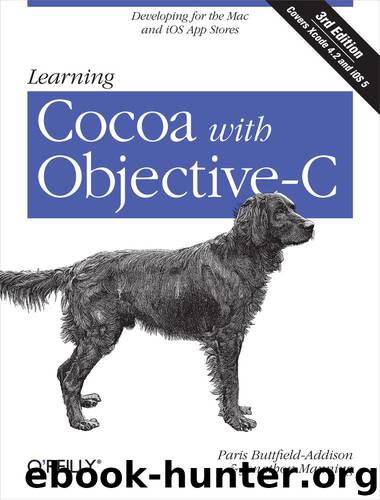Learning Cocoa with Objective-C by Paris Buttfield-Addison & Jonathon Manning

Author:Paris Buttfield-Addison & Jonathon Manning [Paris Buttfield-Addison and Jonathon Manning]
Language: eng
Format: epub
Tags: COMPUTERS / Operating Systems / Macintosh
ISBN: 9781449318789
Publisher: O'Reilly Media
Published: 2012-12-09T16:00:00+00:00
The cell’s primary text label is set to display the text Hello.
Finally, the cell is returned to the table view, which will display it to the user.
Responding to actions
The most common thing that the user does with table view cells is to tap them. When this happens, the table view will contact its delegate and inform it that a cell was selected.
An object must conform to the UITableViewDelegate protocol in order to be a delegate. The table view’s delegate can be different from its data source, but in practice the delegate is the same object as the data source (that is, the view controller that manages the table view conforms to both the UITableViewDelegate and UITableViewDatasource protocols).
There are several methods that UITableViewDelegate specifies, all of which are optional. The most important and commonly used method is tableView:didSelectRowAtIndexPath:, which is called when a row is tapped. This is the delegate’s opportunity to perform an action like moving to another screen.
- (void)tableView:(UITableView *)tableView didSelectRowAtIndexPath:(NSIndexPath *)indexPath { // The table view cell at 'indexPath' got selected }
Download
This site does not store any files on its server. We only index and link to content provided by other sites. Please contact the content providers to delete copyright contents if any and email us, we'll remove relevant links or contents immediately.
| Coding Theory | Localization |
| Logic | Object-Oriented Design |
| Performance Optimization | Quality Control |
| Reengineering | Robohelp |
| Software Development | Software Reuse |
| Structured Design | Testing |
| Tools | UML |
The Mikado Method by Ola Ellnestam Daniel Brolund(20604)
Hello! Python by Anthony Briggs(19900)
Secrets of the JavaScript Ninja by John Resig Bear Bibeault(18208)
Dependency Injection in .NET by Mark Seemann(18109)
The Well-Grounded Java Developer by Benjamin J. Evans Martijn Verburg(17576)
OCA Java SE 8 Programmer I Certification Guide by Mala Gupta(17422)
Kotlin in Action by Dmitry Jemerov(17185)
Adobe Camera Raw For Digital Photographers Only by Rob Sheppard(16934)
Algorithms of the Intelligent Web by Haralambos Marmanis;Dmitry Babenko(16237)
Grails in Action by Glen Smith Peter Ledbrook(15390)
Test-Driven iOS Development with Swift 4 by Dominik Hauser(10394)
Becoming a Dynamics 365 Finance and Supply Chain Solution Architect by Brent Dawson(8056)
Microservices with Go by Alexander Shuiskov(7820)
Practical Design Patterns for Java Developers by Miroslav Wengner(7721)
Test Automation Engineering Handbook by Manikandan Sambamurthy(7672)
Angular Projects - Third Edition by Aristeidis Bampakos(7160)
The Art of Crafting User Stories by The Art of Crafting User Stories(6611)
NetSuite for Consultants - Second Edition by Peter Ries(6533)
Demystifying Cryptography with OpenSSL 3.0 by Alexei Khlebnikov(6305)
